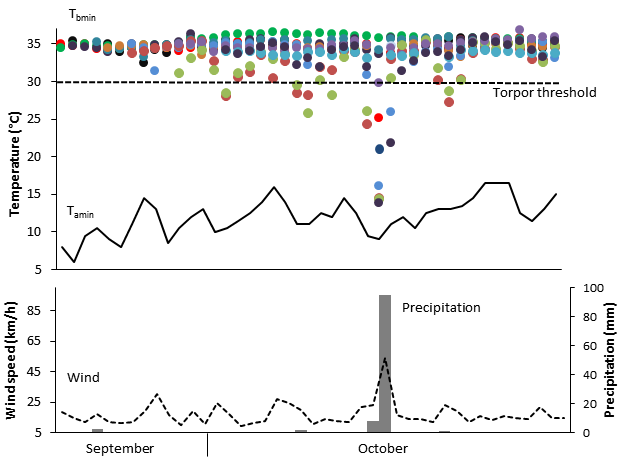Research Focus
My research focuses on physiological adaptations of wild animals, mainly in the context of environmental change, anthropogenic disturbance, and global warming. I am particularly fascinated by the ability of certain species to reduce their energetic requirements during energetic bottlenecks via the use of torpor and how individual differences in physiological and behavioural traits can influence survival.
Please get in touch if you are interested to find out more about current projects.
More Functions of Torpor
During torpor animals reduce body temperature and metabolic rate, which enables them to reduce energy demands and outlast energetic bottlenecks.
Interestingly, torpor is not only used by mammals to survive the cold and unproductive winter season but has many more functions. For example, many species use torpor rather flexible in response to emergency situations, such as fires or storms [1,2]. Furthermore, animals that are able to use torpor (flexibly) are likely to cope better with the challenges of human-induced environmental change.

Evolution of endothermy
I am also interested in the evolution of endothermy recently also started to look into the mechanisms of heat production in mammals (non-shivering thermogenesis; NST). While heat production during cold exposure via UCP1 in the brown adipose tissue (BAT) is well understood, only about 20% of all endotherms possess BAT. Species lacking this mechanism are for example birds, marsupials, monotremes or domestic pigs and wild boars. One possible alternative mechanism of NST is heat production in muscle via Ca2+-cycling. The sarcoplasmic reticulum Ca2+– ATPase 1a (SERCA1a) can produce heat without muscle contraction under the involvement of the protein sarcolipin and muscle-based thermogenesis in mammals and birds coukd infact be a potential driver of the evolution of endothermy [3,4]. My colleagues and I have investigated whether muscle NST is of significance for the thermoregulation of newborn wild boar [5].

Individual differences
Individuals of one population are assumed to adopt different ‘pace of life syndromes’, which represent combinations of traits that together provide optimal ‘solutions’ to cope with different environmental challenges. E.g., individuals with a high resting metabolic rate (energy expenditure) also tend to have bold and active ‘personalities’, and because they find more food, those ‘fast’ syndromes in turn grow faster and produce more offspring (and vice versa for individuals adopting ‘slow’ syndromes). On the other hand, this ‘fast’ syndrome is predicted to be costly in terms of accelerated physiological ageing.
